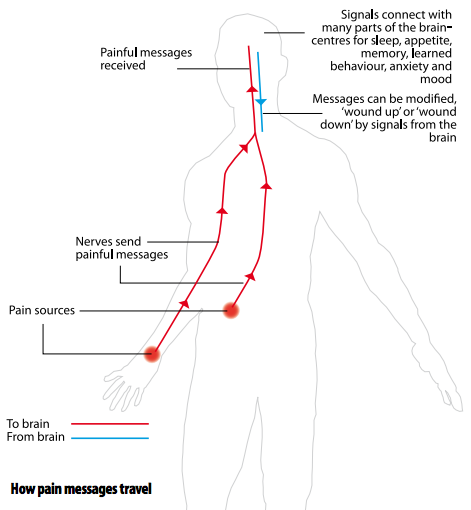REASONS FOR PAIN
Why doesn’t my pain go away?
Health professionals use different terms for different types of pain. Shortterm pain, such as a sprained ankle, is called ‘acute’ pain. Long-term pain, such as back pain, is called ‘persistent’ or ‘chronic’ pain. Pain that comes and goes, like a headache, is called ‘recurrent’ pain. It is not unusual to have more than one sort of pain, or to have pain in several places.
Many acute pains are a useful alarm signal that something is wrong. Most minor ones get better on their own or with simple treatment. Others may be a sign of something more serious, such as a broken leg. This pain is helpful because it means that you get treatment and rest your leg until the break has had a chance to heal. On the other hand, persistent pain appears to serve no useful purpose, but has a huge effect on the lives of many people.
The Pain Mechanism
Pain can come from any part of your body : skin, muscle, ligaments, joints, bones (nociceptive pain), injured tissue (inflammatory pain), nerves (neuropathic pain), internal organs (visceral pain) or a combination of these types of pain (mixed pain).
Pain signals normally travel from the painful part of the body along thousands of specialised nerve fibres, through the spinal cord, to the brain. However, in some cases (for example, pain after a stroke), damage to the brain or to the spinal cord itself can start the pain sensation.
Pain signals are initially processed in the spinal cord and then in the brain, where there are connections with centres associated with anxiety, emotions, sleep, appetite and memory. This creates a very personal experience of pain for each person.
The brain sends signals back to the spinal cord, which can, in turn, either reduce or increase the pain further. Cells at the nerve endings, in the spinal cord and in the brain can become over-sensitised as a result of constant pain input. This is called ‘wind-up’ and is one of the reasons why persistent pain does not go away easily, even if the cause of the pain is discovered and treated.
In simple terms, the body’s warning system becomes more sensitive, producing an increased feeling of pain even though there may no longer be any continuing damage to the body.
Although medical technology is improving all the time, some pain is very complicated. It may involve so many factors that we will never be able to find the precise cause of it accurately with machines, or make it show up in any tests. However, not knowing the cause of the pain does not mean it is not a very real problem.
Only the person in pain can really say how painful something is. Because pain is always personal, no two people experience it in the same way. This makes it very difficult to define and to treat.
Unfortunately, there is more to persistent pain than simply hurting. This is unpleasant enough by itself, but when it continues for a long time, it can affect every part of your life in how you cope with it. It may affect your ability to work, your relationships with family and friends, your activity levels and your sleep. All of this may become overwhelming and can cause a vicious circle of increasing pain and distress.
Pain is never ‘just in the mind’ or ‘just in the body’. It is a complicated mixture of signals from the body and how the brain interprets them.
You know your pain, even though it cannot be seen or measured. The challenge for both you and those treating you is to understand the complicated nature of persistent pain and the best way of managing it.



